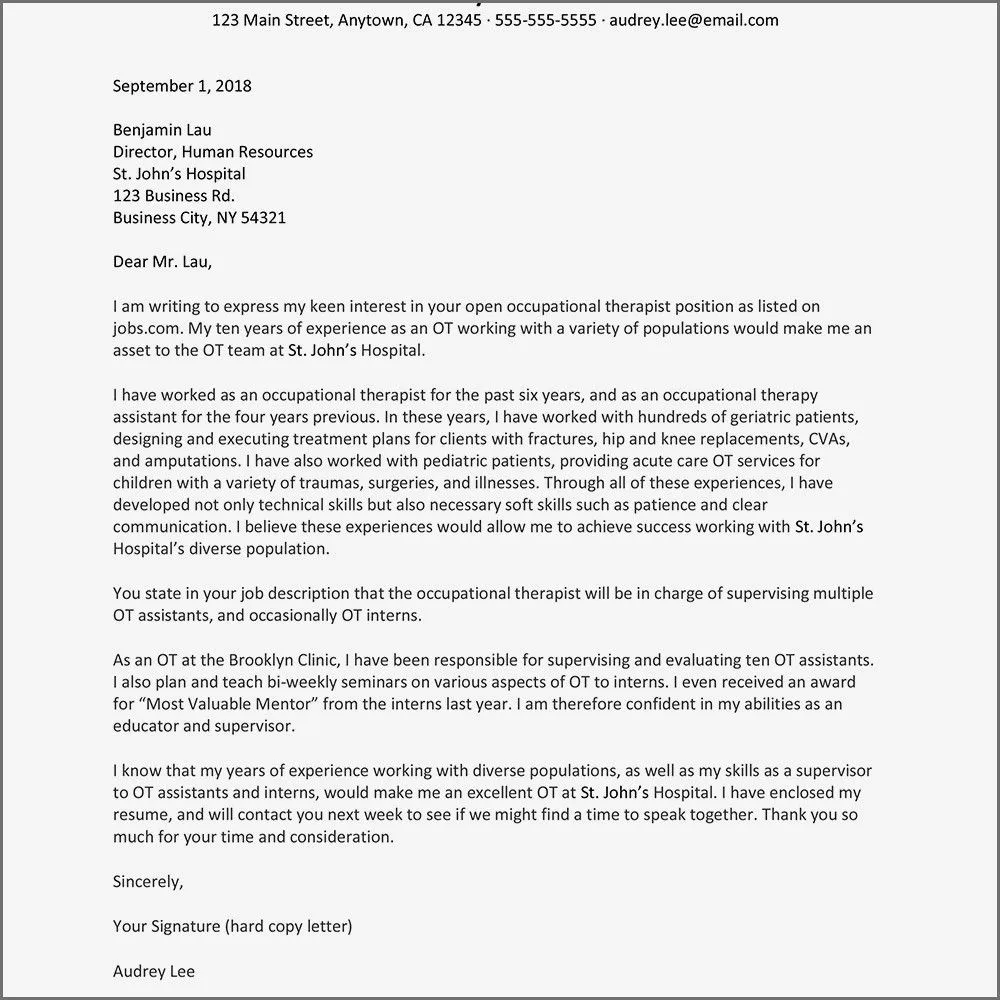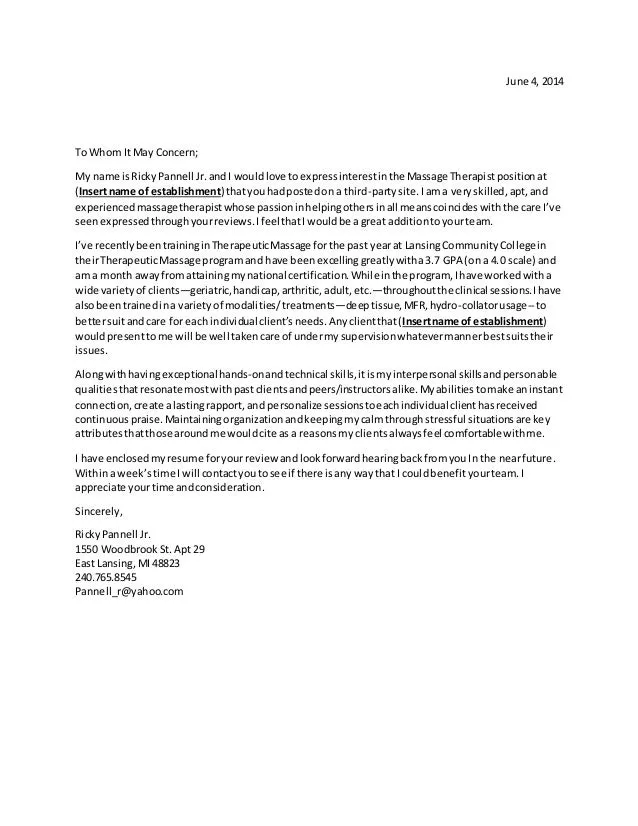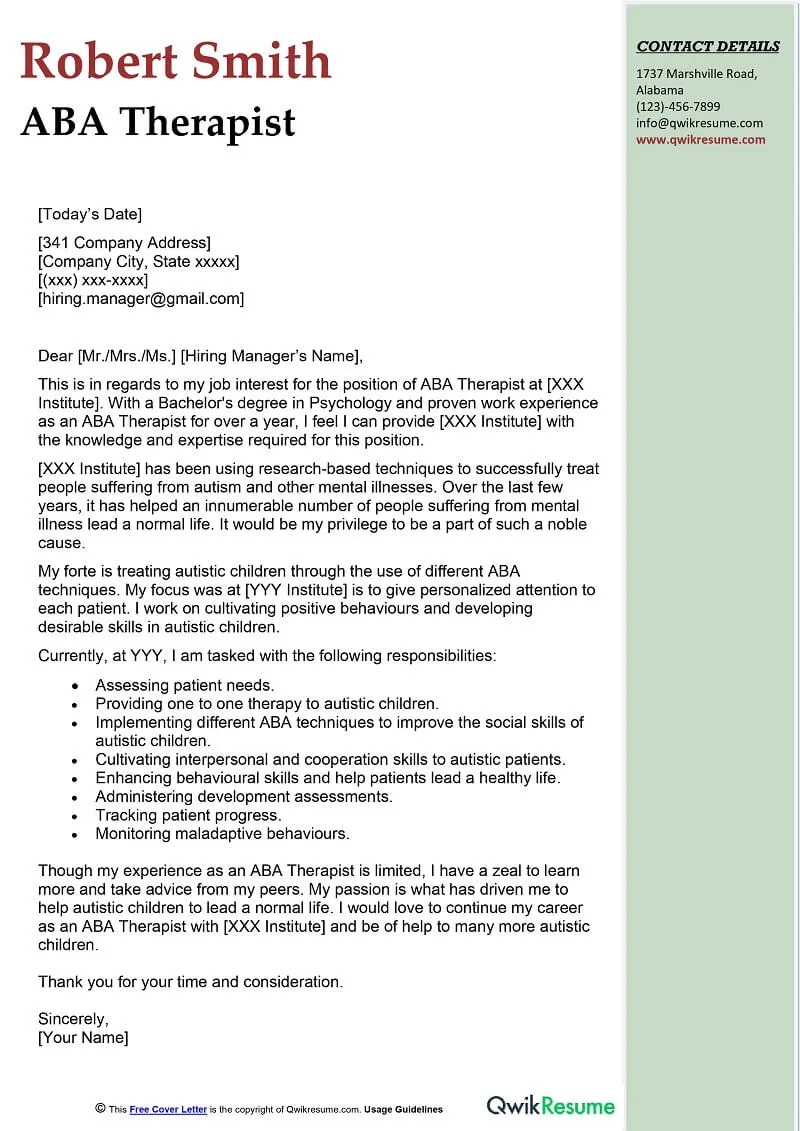Why You Need a Great Massage Therapist Cover Letter
In the competitive world of massage therapy, a well-crafted cover letter is your golden ticket to securing your dream job. It’s your first impression, a chance to showcase your skills, experience, and personality before the hiring manager even sees your resume. Think of it as your personal introduction, a way to make a lasting impact and stand out from the crowd. A strong cover letter demonstrates your genuine interest in the position and the specific clinic or spa, setting the stage for a successful application. A generic or poorly written cover letter, on the other hand, can easily land your application in the rejection pile. It’s an opportunity to bridge the gap between your qualifications and the employer’s needs, proving that you are the ideal candidate to join their team. Taking the time to create a compelling cover letter is an investment in your career, increasing your chances of landing an interview and ultimately, the job.
Essential Components of a Massage Therapist Cover Letter
A successful massage therapist cover letter requires several key components to effectively communicate your qualifications and passion. The structure should be clear and concise, guiding the reader through your key strengths. Begin with your contact information and the date, followed by the recipient’s information. This sets a professional tone from the outset. Next, craft a compelling opening that immediately grabs the reader’s attention, expressing your interest in the position and the company. In the body paragraphs, highlight your massage therapy skills, detailing your experience, including the types of massage you specialize in, and any specialized training you have. Showcase your relevant certifications and licenses, demonstrating your professional qualifications. Emphasize your passion for massage therapy, explaining what motivates you and how you contribute to client well-being. Conclude with a strong call to action, expressing your availability for an interview and thanking the employer for their consideration. Formatting and proofreading are essential to ensure that your cover letter looks professional and is free of errors.
Contact Information and Salutation

Your cover letter should begin with your contact information, including your name, phone number, email address, and optionally, your LinkedIn profile URL. This should be followed by the date and the hiring manager’s name and the clinic or spa’s address. Use a professional salutation, such as “Dear Mr./Ms. [Last Name],” if you know the hiring manager’s name. If you are unsure, use “Dear Hiring Manager” or “Dear [Clinic/Spa Name] Team.” Avoid generic greetings like “To Whom It May Concern.” Accuracy here is critical, as it demonstrates your attention to detail and respect for the potential employer. Ensuring the recipient’s information is correct shows you’ve taken the time to research the company and tailor your application accordingly. This attention to detail can significantly impact the first impression you make.
Crafting a Compelling Opening
The opening paragraph of your cover letter is crucial; it’s your chance to capture the hiring manager’s attention and create a positive first impression. Start by clearly stating the position you are applying for and how you learned about it. Then, express your enthusiasm for the role and the clinic or spa. Highlight something specific that attracted you to the position or the company. This could be their reputation, their specialization in a particular massage therapy technique, or their commitment to client care. Avoid generic phrases; instead, show genuine interest. For example, you could mention how impressed you are with their online reviews or their focus on holistic wellness. A well-crafted opening sets the stage for the rest of your letter, encouraging the reader to continue and learn more about your qualifications.
Highlighting Your Massage Therapy Skills
In the body of your cover letter, it’s essential to highlight your relevant massage therapy skills. This is where you showcase your expertise and demonstrate how you can meet the employer’s needs. Describe the massage techniques you specialize in, such as Swedish, deep tissue, sports massage, or prenatal massage. Provide specific examples of your experience. For example, you could describe how you use your skills to help clients with chronic pain, improve their range of motion, or reduce stress. Quantify your achievements whenever possible. For instance, you could mention the number of clients you’ve treated, the positive feedback you’ve received, or any increase in client satisfaction scores. Tailor your skills to match the job description. Review the requirements carefully and emphasize the skills that are most relevant to the position. This targeted approach shows that you have carefully considered the role and are a good fit for the clinic or spa.
Detailing Your Experience

Your experience is a critical component of your massage therapist cover letter. Provide a brief overview of your work history, including the names of previous employers, your job titles, and the dates of employment. Focus on your relevant experience and highlight your accomplishments in each role. Rather than simply listing your responsibilities, describe what you achieved. For instance, you might mention how you increased client retention rates, improved the efficiency of your appointment scheduling, or successfully managed client records. Use action verbs to describe your contributions. For example, use words like “administered,” “provided,” “managed,” “developed,” and “achieved.” Tailor your experience to the job description by emphasizing the experiences and skills that align with the specific requirements of the role. This demonstrates that you have the practical knowledge and abilities necessary to succeed in the position.
Showcasing Your Relevant Certifications and Licenses
In your cover letter, clearly state your massage therapy certifications and licenses. This demonstrates your professional qualifications and assures the employer that you meet the necessary requirements to practice massage therapy. List your certifications, such as those from the National Certification Board for Therapeutic Massage & Bodywork (NCBTMB) or other recognized organizations. Include your license number, the state in which you are licensed, and the date of issue. If you have any specialized certifications, such as those in sports massage or lymphatic drainage, be sure to mention them. These certifications can set you apart from other candidates, demonstrating your expertise in specific areas of massage therapy. Always ensure that your licenses and certifications are current and valid, as this is a critical requirement for employment in the field.
Emphasizing Your Passion for Massage Therapy
Let your passion for massage therapy shine through in your cover letter. Explain what motivates you and why you enjoy this profession. This helps the hiring manager understand your values and whether you’re a good fit for their team. Discuss your approach to client care, and how you prioritize client well-being and satisfaction. Show your enthusiasm for helping people. You can also share your commitment to continuing education and professional development in massage therapy. This shows that you’re dedicated to staying current with the latest techniques and advancements in the field. By expressing your genuine passion, you will create a more memorable and compelling impression on the hiring manager, making them more likely to consider you for the role.
Concluding Your Cover Letter with a Strong Call to Action

The conclusion of your cover letter is your final opportunity to make a positive impression. Restate your interest in the position and reiterate why you are a good fit for the role. Express your availability for an interview and provide your contact information again. Clearly state how you would like the hiring manager to contact you, whether it’s by phone or email. Thank the employer for their time and consideration. A strong call to action should be direct, clear, and enthusiastic. For example, you might say, “I am eager to discuss my qualifications further and am available for an interview at your earliest convenience. Thank you for your time and consideration.” End with a professional closing, such as “Sincerely” or “Best regards,” followed by your typed name.
Formatting Your Cover Letter
The appearance of your cover letter is just as important as the content. Proper formatting makes your letter easy to read and demonstrates your professionalism. Use a standard font like Times New Roman, Arial, or Calibri, and keep the font size between 10 and 12 points. Use single spacing within paragraphs and double spacing between paragraphs. Align your text to the left and avoid justification. Use clear and concise language, and keep your paragraphs relatively short to maintain reader engagement. Be sure to use appropriate headings and subheadings to organize your information and make it easy to scan. Ensure that there are no spelling or grammatical errors, as this can significantly impact your credibility. Aim for a professional and polished appearance, as this reflects well on your attention to detail and commitment to quality.
Proofreading for Errors
Before submitting your cover letter, thoroughly proofread it for any errors. Spelling and grammatical errors can undermine your credibility and may lead the hiring manager to question your attention to detail. Carefully review your cover letter, checking for typos, grammatical mistakes, and punctuation errors. Consider using a spell checker and grammar checker, but don’t rely on them entirely. Have a friend, family member, or career counselor review your cover letter as a fresh set of eyes can often catch errors that you may have missed. Read your cover letter aloud to catch any awkward phrasing or sentence structures. It is also helpful to print out a hard copy of your letter and review it with a pen, as this allows you to catch errors more easily. A well-proofread cover letter demonstrates your professionalism and attention to detail, significantly improving your chances of success.
